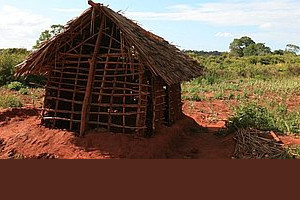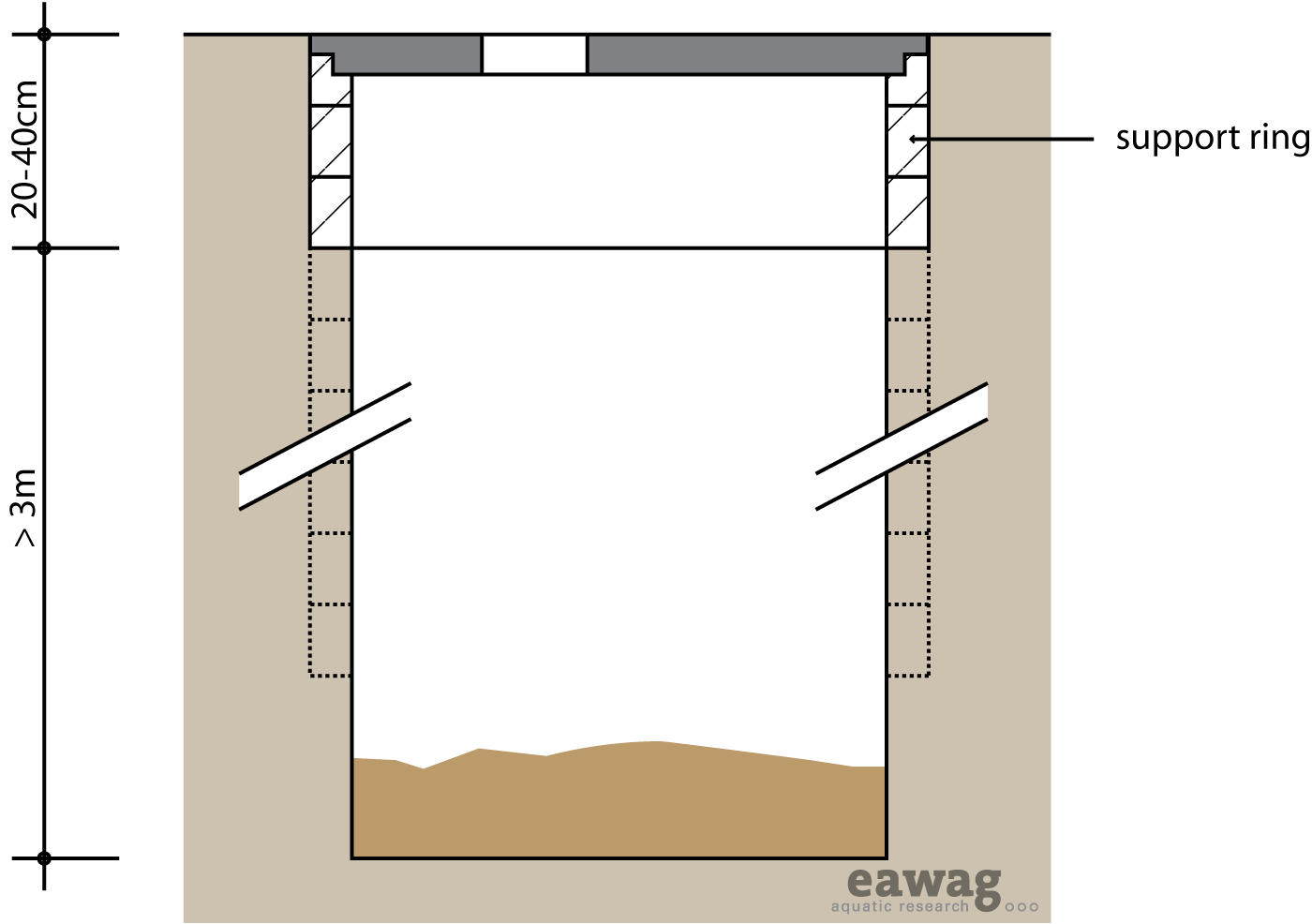Single Pit
|
|
|||||||||||||||||||||||||||
The Single Pit is one of the most widely used sanitation technologies. Excreta, along with anal cleansing materials (water or solids) are deposited into a pit. Lining the pit prevents it from collapsing and provides support to the superstructure.
As the single pit fills, two processes limit the rate of accumulation: leaching and degradation. Urine and water percolate into the soil through the bottom of the pit and wall, while microbial action degrades part of the organic fraction.
Design Considerations: On average, solids accumulate at a rate of 40 to 60 L per person/year and up to 90 L per person/year if dry cleansing materials such as leaves or paper are used. The volume of the pit should be designed to contain at least 1,000 L. Typically, the pit is at least 3 m deep and 1 m in diameter. If the pit diameter exceeds 1.5 m, there is an increased risk of collapse. Depending on how deep they are dug, some pits may last 20 or more years without emptying. To prevent groundwater contamination, the bottom of the pit should be at least 2 m above groundwater level (rule of thumb). If the pit is to be reused, it should be lined.
Pit lining materials can include brick, rot-resistant timber, concrete, stones, or mortar plastered onto the soil. If the soil is stable (i.e., no presence of sand or gravel deposits or loose organic materials), the whole pit need not be lined. The bottom of the pit should remain unlined to allow for the infiltration of liquids out of the pit. As liquid leaches from the pit and migrates through the unsaturated soil matrix, pathogenic germs are sorbed to the soil surface. In this way, pathogens can be removed prior to contact with groundwater. The degree of removal varies with soil type, distance travelled, moisture and other environmental factors and, thus, it is difficult to estimate the distance necessary between a pit and a water source. A minimum horizontal distance of 30m is normally recommended to limit exposure to microbial contamination.
When it is not possible to dig a deep pit or the groundwater level is too high, a raised pit can be a viable alternative: the shallow pit can be extended by building the pit upwards with the use of concrete rings or blocks. A raised pit can also be constructed in an area where flooding is frequent in order to keep water from flowing into the pit during heavy rain. Another variation is the unlined shallow pit that may be appropriate for areas where digging is difficult. When the shallow pit is full, it can be covered with leaves and soil, and a small tree can be planted (see Arborloo, D.1).
A Ventilated Improved Pit (VIP, S.3) is slightly more expensive than a single pit, but greatly reduces the nuisance of flies and odours, while increasing comfort. If a urine-diverting User Interface is used, only faeces are collected in the pit and leaching can be minimized.
Another variation is the unlined shallow pit that may be appropriate for areas where digging is difficult. When the shallow pit is full, it can be covered with leaves and soil and a small tree can be planted. This concept is called the Arborloo and is a successful way of avoiding costly emptying, while containing excreta, and reforesting an area. The Arborloo is discussed in more detail on the Fill and Cover - Arborloo section.
| Advantages | Disadvantages/limitations |
|---|---|
| - Can be built and repaired with locally available materials. - Low (but variable) capital costs depending on materials and pit depth. |
- Flies and odours are normally noticeable. - Low reduction in BOD and pathogens with possible contamination of groundwater. - Costs to empty may be significant compared to capital costs. - Sludge requires secondary treatment and/or appropriate discharge. |
Contents
Appropriateness
Treatment processes in a single pit (aerobic, anaerobic, dehydration, composting or otherwise) are limited and, therefore, pathogen reduction and organic degradation is not significant. However, since the excreta are contained, pathogen transmission to the user is limited.
Single pits are appropriate for rural and peri-urban areas; in densely populated areas they are often difficult to empty and/or have insufficient space for infiltration. Single pits are especially appropriate when water is scarce and where there is a low groundwater table. They are not suited for rocky or compacted soils (that are difficult to dig), or for areas that flood frequently.
Health Aspects/Acceptance
A simple Single Pit is an improvement to open defecation; however, it still poses health risks:
- Leachate can contaminate groundwater;
- Stagnant water in pits may promote insect breeding;
- Pits are susceptible to failure/overflowing during floods.
Single pits should be constructed at an appropriate distance from homes to minimize fly and odour nuisances and to ensure convenience and safety.
Upgrading
A Ventilated Improved Pit (VIP) is slightly more expensive but greatly reduces the nuisance of flies and odours, while increasing comfort and usability. For more information on the VIP please refer to the Single Pit VIP page. When two pits are dug side-by-side, one can be used while the contents of the other pit are allowed to mature for safer emptying. For more information on dual pit technologies refer to Double Pit VIP and Twin Pits for Pour Flush pages.
Operation & Maintenance
There is no daily maintenance associated with a single pit apart from keeping the facility clean. However, when the pit is full it can be a) pumped out and reused or b) the superstructure and squatting plate can be moved to a new pit and the previous pit covered and decommissioned, which is only advisable if plenty of land area is available.
Field experiences
 Ensure access to safe water and sanitation |
 Water, Food & Sanitation for School + Community |
References
- ARGOSS (2001). Guidelines for Assessing the Risk to Groundwater from on-Site Sanitation. British Geological Survey Commissioned Report, CR/01/142, Keyworth, UK.
- Brandberg, B. (1997). Latrine Building. A Handbook for Implementation of the Sanplat System. Intermediate Technology Publications, London, UK. (Book; a good summary of common construction problems and how to avoid mistakes)
- Franceys, R., Pickford, J. and Reed, R. (1992). A Guide to the Development of on-Site Sanitation. WHO, Geneva, CH. (For information on accumulation rates, infiltration rates, general construction and example design calculations)
- Graham, J. P. and Polizzotto, M. L. (2013). Pit Latrines and Their Impacts on Groundwater Quality: A Systematic Review. Environmental Health Perspectives, National Institute of Environmental Health Sciences, Research Triangle Park, US.
- Pickford, J. (1995). Low Cost Sanitation. A Survey of Practical Experience. Intermediate Technology Publications, London, UK. (Book; Information on how to calculate pit size and technology life)
- Robens Institute (1996). Fact Sheets on Environmental Sanitation. Fact Sheet 3.4: Simple Pit Latrines. University of Surrey, UK and WHO, Geneva, CH.
Acknowledgements
The material on this page was adapted from:
Elizabeth Tilley, Lukas Ulrich, Christoph Lüthi, Philippe Reymond and Christian Zurbrügg (2014). Compendium of Sanitation Systems and Technologies, published by Sandec, the Department of Water and Sanitation in Developing Countries of Eawag, the Swiss Federal Institute of Aquatic Science and Technology, Dübendorf, Switzerland.
The 2nd edition publication is available in English. French and Spanish are yet to come.


